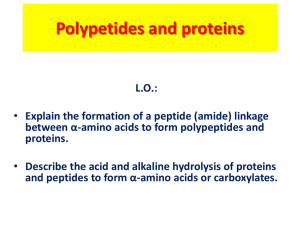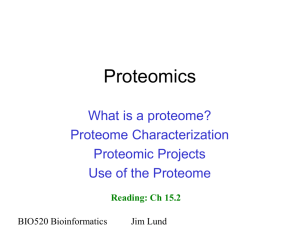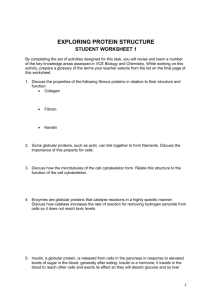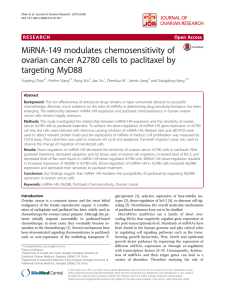Maria Paola Costi
advertisement
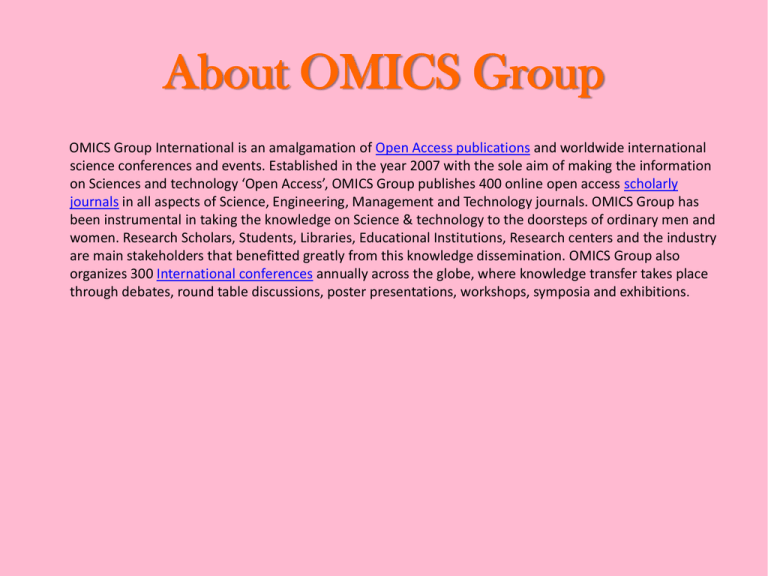
About OMICS Group OMICS Group International is an amalgamation of Open Access publications and worldwide international science conferences and events. Established in the year 2007 with the sole aim of making the information on Sciences and technology ‘Open Access’, OMICS Group publishes 400 online open access scholarly journals in all aspects of Science, Engineering, Management and Technology journals. OMICS Group has been instrumental in taking the knowledge on Science & technology to the doorsteps of ordinary men and women. Research Scholars, Students, Libraries, Educational Institutions, Research centers and the industry are main stakeholders that benefitted greatly from this knowledge dissemination. OMICS Group also organizes 300 International conferences annually across the globe, where knowledge transfer takes place through debates, round table discussions, poster presentations, workshops, symposia and exhibitions. About OMICS Group Conferences OMICS Group International is a pioneer and leading science event organizer, which publishes around 400 open access journals and conducts over 300 Medical, Clinical, Engineering, Life Sciences, Pharma scientific conferences all over the globe annually with the support of more than 1000 scientific associations and 30,000 editorial board members and 3.5 million followers to its credit. OMICS Group has organized 500 conferences, workshops and national symposiums across the major cities including San Francisco, Las Vegas, San Antonio, Omaha, Orlando, Raleigh, Santa Clara, Chicago, Philadelphia, Baltimore, United Kingdom, Valencia, Dubai, Beijing, Hyderabad, Bengaluru and Mumbai. A proteomic-bioinformatic integrated approach for studying the effect of a peptide drug candidate on ovarian Cancer Maria Paola Costi Department of Life Science Unimore Modena 6th Annual EUTROC Meeting Hammersmith Hospital, London Saturday 12th July 2014 SCIENTIFIC PROGRAMME Session 1 - Chairs: Franca Esposito (University of Naples Federico II) / Mara Kyrgiou (Imperial College London) 9.00 – 9.10 Hani Gabra (Imperial College London) Introduction On behalf of the organising committee, we would like to invite you to the 6th Annual Ovarian Cancer • Ovarian Cancer (OC) It is the most lethal of the gynecologic malignancies • Non specific symptoms that accompany the early disease OC diagnosis in advanced stage therapeutic options are limited. CAUSES OF FAILURE FIRST LINE TREATMENT surgical cytoreduction + OC diagnosis in advanced stage (FIGO Stages IIB to IV) Rapid occurrence of resistance to the standard systemic therapies chemotherapy (and/or radiotherapy) Chemiotherapy Platinum (cisplatin) /taxane (paclitaxel) combination High initial response (≈ 70%) High percentage of relapse after 6 months (> 90%) Our aims are 1. to develop new drugs against resistant ovarian cancer 2. to provide a new methodology for fingerprint evaluation of biomolecules changes in cells 3. to translate the concept to clinical samples Development of new drugs against resistant ovarian cancer Fingerprint design Design & chemistry Recombinant protein and cell lines evaluation Selection and optimizations Mass spectrometry identification Fingerpint validated, biology studies and mechanism explored. Thymidylate synthase and folate pathway targeting Targeting Thymidylate synthase pathways hTS monomers hTS dimer active/inactive + ? hTS HN O N 2' deoxy-ribose mRNA O O dUMP mTHF CH3 HN O N 2' deoxy-ribose dTMP DNA New strategies against resistant ovarian cancer (ROC) Antifolate peptides Pemetrexed (AlimtaTM) Binding at TS dimeric interface Binding at TS active site Under clinical evaluation for ROC Proteomic evaluation of the effect of peptides on: OC cell lines Primary tumor tissues Cardinale D. et al.,PNAS, 2011, Pelà et al, J Med Chem.2014 •PMX (AlimtaTM) is an antifolate that inhibits TS, DHFR, GART and ATIC. •14 clinical trials Pemetrexed phase II •Proteomic evaluation of the effect of PMX on: OC cell lines OC biopsies from a Phase II clinical trial Can we approach the whole proteomic/tar geted proteomic approach for a wider view of lead/drugs effect? Targeting the same target, different mechanism of inhibition Different cellular protein profile? Need for a more integrated non reductionistic approach Study of the effect of antifolate peptides in the cell lines through Proteomic-bioinformatic approach A2780 A2780/CP IGROV1 Treated with LR, LR-DGln4 and PMX To define a Protein Profile: proteins expression could be informative of the effect of peptides on OC cell lines. Whole proteome analysis: MS label free quantification approach Differential proteomic analysis: Treated with LR peptide VS Control Bioinformatic studies Of Differentially Expressed Proteins (Pathways modulated) Protein Panel selection for Western blot validation. Western blot and Analysis of Data Protein profile definition Differential proteomic and bioinformatic approach NETWORK ANALYSIS OF DEPS 64 out of 160 DEPs resulted connected using interrogation through: - BioGrid, IntAct and Reactome Up – regulated Down – regulated Up/Down – regulated FOUR MAIN CLUSTER ARE MODULATED BY LR •Cluster a ribosomal proteins. •Cluster b proteins of pyrimidine ribonucleotide metabolic process, proteins RNA-connected and protein transport-connected. •Cluster c ribonucleoproteins. •Cluster d proteasome complex. Up – regulated Down – regulated Up/Down – regulated Functional neighbors Folate Pathway Members connected to DEPs Up–regulated Down–regulated Up/Down–regulated Folate–related PMX-related Physical protein interactions Lecture protein interactions 35 proteins from the original dataset and 14 folateassociated proteins Proteins Panel Selection 4 proteins known to be directly involved in the folate cycle 3 folate related protein neighbor to proteins deregulated by LR treatment 3 differentially expressed proteins DEPs Western Blot targeted approach and panel validation Differential Proteomic Analysis Bioinformatics analysis 10 proteins selected WESTERN BLOT ANALYSIS How can we translate the profile in a easy read-out? Peptide L-Barcode A2780 peptide barcode LR 0 1 2 3 4 5 6 7 8 9 PROTEIN CODE: 0=GART, 1=TRAP1, 2=DHFR, 3=HSP90AA1, 4=ATIC, 5=MGMT, 6=TS, 7=MTHFR, 8=EIF2S1, 9=SHMT1 LR treatment vs A2780 & IGROV1 2.0 A2780 IGROV1 treated with LR 5 μM (n=3) 1.5 1.0 0.5 0.0 EIF2S1 MTHFR DHFR HSP90AA1 ATIC MGMT TS TRAP1 GART SHMT1 -0.5 -1.0 A2780 LR 0 1 2 34 5 6 7 8 9 IGROV1 LR 0 1 2 34 5 6 7 89 LR effect in sensitive OC cell lines Conserved IGROV1 code: peptide barcode 0 = GART 1 = TRAP1 2 = DHFR 3 = MGMT 4 = ATIC 5 = HSP90AA1 6 = TS LR 0 1 2 34 5 LR 0 IGROV1/A2780 A2780 peptide peptide barcode barcode 6 7 89 1 2 34 5 LR 0 6 XXX 1 2 34 5 CONSERVED code 6 7 89 VARIABLE code 4 LR-DGln 1.5 treatment vs A2780 & IGROV1 A2780 IGROV1 treated with LR-DGln4 5 μM (n=3) 1.0 0.5 0.0 EIF2S1 MTHFR DHFR HSP90AA1 ATIC MGMT TS TRAP1 GART SHMT1 -0.5 -1.0 A2780 peptide barcode LR-DGln4 0 1 2 34 5 6 7 8 9 IGROV1 peptide barcode LR-DGln4 0 1 2 34 5 6 7 8 9 4 LR-DGln peptide L-barcode IGROV1 peptide barcode IGROV1/A2780 peptide A2780 peptide barcodebarcode DGln4 0 1 2 345 6 7 8 9 DGln4 0 1 2 345 6 7 8 9 SIMILAR CONSERVED CODES LR 0 1 2 3 4 5 6 X X X LR/LRDGln4 0 1 2 3 4 X X X X X SUGGESTING the SAME MECHANISM OF ACTION Cisplatin resistant/sensitive OC cell lines A2780/CP peptide barcode 1.5 A2780/CP A2780 treated with LR 5 μM (n=3) 1.0 0.5 0.0 EIF2S1 LR-DGln4 0 MTHFR DHFR HSP90AA1 ATIC MGMT TS TRAP1 GART SHMT1 1 2 3 45 6 7 8 9 -0.5 -1.0 A2780 peptide barcode SIMILAR CONSERVED CODES A2780/CP LR-DGln4 0 1 2 X 4 5 X X X X A2780 LR-DGln4 0 1 2 3 45 67 8 9 LR-DGln4 0 1 2 3 4 X X X X X SAME MECHANISM OF ACTION Peptides L-barcode LR/LR-DGln4 0 1 2 3 X 5 X X X X X 0 = GART 1 = TRAP1 2 = DHFR 5 = HSP90AA1 X variable PTX barcode Vs A2780 PTX barcode PTX 0 1 2 3 4 5 6 7 8 9 DIFFERENTS BARCODES DIFFERENT MECHANISM OF ACTION 4 LR-DGln barcode A2780 A2780 PTX/peptide peptide barcode barcode LR-DGln4 0 1 2 3 4 5 6 7 8 9 Statistical analysis of the WB results Heat map PCA. Different clusters for a different mechanism Heatmap. Blue down expression, red high expressing F.Genovese, MPCosti et al. J.Proteom Research, submitted What is the biological meaning of the protemic signature identified? Looking for a protein signature induced by LR…. OC A2780 CELLS CONTROL vs LR-peptide TREATED ..a proteomicsbioinformatics combined approach led to the identification of a set of proteins regulated upon treatment with LRderived peptides. TRANSLATION OF THE PROTEOMIC RESULTS INTO BIOLOGICAL/MOLECULAR EFFECTS ON OVARIAN CANCER CELLS! DI-INACTIVE CONFORMATION ACTIVE CONFORMATION CK2 and other kinases P [DGln4] LR Ubiquitin-proteasome system Ribosomal proteins, RNA metabolism and translational initiation Stress-responsive pathways P TRANSLATIONAL BLOCK eIF2A phosphorylation BINDING TO SEVERAL CELLULAR mRNAs (TRANSCRIPTION FACTORS? RNA binding proteins/TRANSLATIONAL REPRESSORS? Stressresponsive proteins?) TRAP1 VDAC1 HSP90 -Opening of mitochondrial transition pore (MTP) -ROS increase APOPTOTIC CELL DEATH Conclusions 1. The results confirm that our new methodology provides: a) An approach to the discovery of molecular drug targets/off-targets which could be part of a pharmacodynamic profile to monitor candidate drugs activity since the very early phases of the drug development process. b) Deregulations can be mainly assigned to the following processes or functions: • regulation of translational initiation, • termination of RNA Pol-II transcription, • transport, • proteasome. 2. different expression level changes observed consequently to our peptides treatment in comparison with a folate antagonist currently used in therapy, Pemetrexed, are in agreement with the hypothesized different mechanism of action. AIRC_DROC Targeting Drug Resistance in Ovarian Cancer Filippo Genovese Alessandra Gualandi Chiara Marraccini Silvia Pirondi Leda Severi Andrea Martello Domenico D’Arca ASSOCIAZIONE ITALIANA PER LA RICERCA SUL CANCRO Maria Rosaria Amoroso Gaetano Marverti Paul Perco Michela Pelà Remo Guerrini Glauco Ponterini Maria Paola Costi Thank you. Let Us Meet Again We welcome you all to our future conferences of OMICS Group International Please Visit: www.omicsgroup.com www.conferenceseries.com www.pharmaceuticalconferences.com

